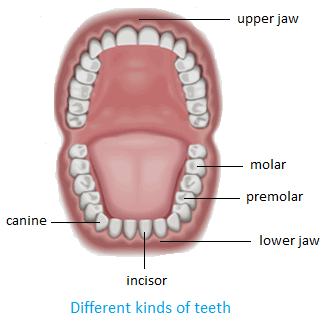Kinds of Teeth
There are different kinds of teeth. Let’s open our mouth and look into the mirror and compare the teeth in front and at the back. We find different types of teeth in our mouth. The teeth are of different shapes because they have different uses.
There are four different kinds of teeth.
They are the following:
Incisors: The teeth in front are for cutting. Those teeth are known as incisors. In all there are 8 incisors.
Canines: The teeth next to the incisors are sharp and pointed.
They are used for tearing food. For example, used for tearing meat. Those teeth are known as canines. In all there are 4 canines.
Premolars and molars: The teeth at the back of our mouth are flat and wide. Those teeth are known as premolars and molars. These teeth are used to crush and grind the food. There are 8 premolars and 12 molars.
We know an adult person has 32 teeth. There are 16 teeth in the lower jaw and 16 in the upper jaw.
Let us observe how we use our different kinds of teeth while we eat different food.
(i) When we bite into an apple then we use our incisors. Because we know incisors are our front teeth which we use for cutting the apple. Now after cutting the apple then we chew the apple. To chew the apple we use our premolars and molars. Because we know premolars and molars are used to crush and grind the apple.
(ii) When we tear the meat then we use our canines. Because we know canines are sharp and pointed which we use for tearing the meat. Now after tearing the meat then we chew the meat. To chew the meat we use our premolars and molars. Because we know premolars and molars are used to crush and grind the meat.
From Kinds of Teeth to HOME PAGE
Recent Articles
-
What Is Plasma? | Blood Plasma | Proteins | Nutrients | Cholesterol
Nov 07, 25 10:29 AM
Blood is a mobile fluid which is a connective tissue and is derived from the mesoderm like cell any other connective tissue. Colour of blood is reddish and that flows inside the blood vessels by means… -
Disorders of Respiratory System | Tuberculosis | Pleurisy | Emphysema
Oct 28, 25 11:39 PM
Tuberculosis is very common disease and is caused by a type of bacteria called Mycobacterium tuberculosis. This disease causes different trouble in the respiration and infection of several parts of th… -
Regulation of Respiration | Respiratory Centres | Inspiratory Area |
Oct 14, 25 12:13 AM
Respiratory Centre is the area that controls the rate of respiration and it is observed to be located in medulla oblongata and pons. Respiratory Centre has the following will dispersed components like… -
Explain Transport of Gases | External Respiration | Tissue Respiration
Oct 09, 25 11:35 PM
In humans gaseous exchange is completed in the following ways the steps are - External Respiration or Breathing - Breathing in false taking in of Oxygen and giving out of carbon dioxide in the body. M… -
Kind and Number of Teeth | Location of Teeth in Mouth | Care of Teeth
Sep 11, 25 12:52 AM
Kind and Number of Teeth









New! Comments
Have your say about what you just read! Leave me a comment in the box below.